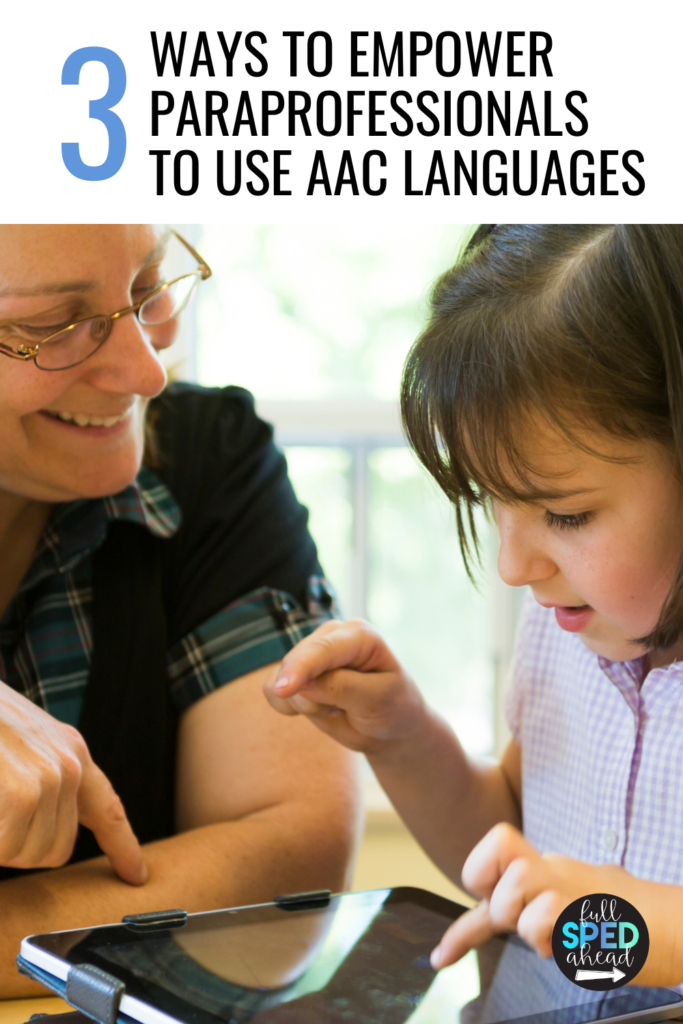I am excited to introduce this week’s guest bloggers, Janna and Morgan from ABA Visualized, they wrote the book AAC Visualized because they believe everyone should have a voice! They are here to share their best tips for Paraprofessionals to learn AAC languages.

Paraprofessionals are indispensable partners in the education of students with diverse communication needs. Their continuous presence and individualized support make them vital contributors to the educational process. Recent research reveals that paraprofessionals often implement interventions independently, without immediate teacher support. Hence, it’s crucial to empower these professionals with the confidence and skills to use Augmentative and Alternative Communication (AAC) tools effectively. Here are three practical strategies to achieve AAC languages:
Here are a few ways to use visuals in the classroom.
Make AAC learning an exciting journey for paraprofessionals. Initially, using AAC tools with students may appear daunting, especially given the variety of AAC “languages” such as Proloquo and LAMP. To empower paraprofessionals and help them bridge the knowledge gap, it’s essential to incorporate opportunities for their own AAC skill development into daily routines. This includes allocating time for them to explore AAC devices independently to enhance their fluency.

To best meet the needs of AAC users, it’s crucial for the entire team to become proficient in their chosen AAC language. Paraprofessionals, with their frequent one-on-one interactions with students, are uniquely positioned for this role. In cases where a student might have forgotten their AAC device or it has run out of battery, a practical solution is to capture a screenshot of the student’s AAC device’s main screen, print it, and laminate it to create a personalized core board that mirrors the student’s communication system.
Creating an environment where paraprofessionals feel comfortable asking questions and seeking clarification is vital. Additionally, identifying which paraprofessionals are most comfortable with specific AAC languages and pairing them with students who use those languages can break down communication barriers. This “feature matching” practice fosters a more inclusive and empowered learning environment.
Empowering paraprofessionals to embrace AAC doesn’t mean they need to become AAC experts overnight. Start by introducing small, manageable tasks that familiarize them with AAC and its various aspects. For example, one paraprofessional could oversee the morning routine of ensuring all devices are accessible to students (by taking students’ AAC devices out of student backpacks), while another could manage device charging and return at the end of the day.
Encourage students to embark on their AAC journey with gradual steps, making learning fun! Whenever a student successfully uses a new word or phrase with AAC, celebrate it as a class. Share these victories with peers, teachers, and parents to foster enthusiasm. By taking a gradual approach and acknowledging every success, you create a warm and supportive environment for everyone involved in the AAC journey.
Empowering paraprofessionals to support AAC newcomers involves teaching them how to incorporate AAC modeling into everyday activities seamlessly. Let’s make this process easy and enjoyable! This is perfect for Lamp Words for Life, or any other augmentative and alternative communication AAC device.
Start by providing clear guidance on using AAC for communication during daily routines, such as art class, play time, morning meetings, and outdoor play. Initially, the focus is on modeling, where the goal is to demonstrate AAC languages system use without expecting the learner to respond with AAC immediately. This phase introduces common words used in daily activities to build language skills.
Learn more about how to use core vocabulary in the classroom.
One effective approach is the “Word of the Week” (WOW) strategy, where the team selects a core word each week and models its use through AAC throughout the day in various contexts. Core words are high-frequency words like, “go,” “stop,” “like,” “play,” “eat,” and “you,” and these words are so powerful to learn because they constitute 80% of our language! Encourage paraprofessionals to embrace and practice core vocabulary, as it forms a solid foundation for effective communication.

We’ve illustrated this strategy in our book, AAC Visualized, providing real-life examples and step-by-step visual instructions. In the WOW strategy, the team should speak in full sentences while consistently modeling the Word of the Week using AAC languages throughout the day. To personalize this approach, share students’ Individualized Education Program (IEP) goals with paraprofessionals for tailored AAC modeling and word selection based on each student’s specific needs.
AAC Language Lab is also a great resource to check out!
By making AAC modeling a natural part of daily activities, we empower both paraprofessionals and students in their communication journey. Let’s dive in together and make communication enjoyable and accessible for all!

What are you looking for?
COPYRIGHT © 2025 Full SPED Ahead